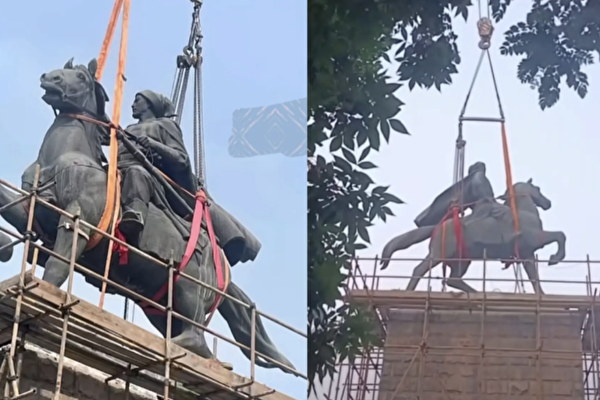Recently, the statue of Li Zicheng located at the Changping Xiguan roundabout in Beijing was removed by the authorities. It is officially stated that the plan is to relocate the statue to Li Zicheng’s “hometown” in Shaanxi. Many internet users speculate that the authorities fear a popular uprising.
A viral video online shows that the Chinese Communist Party authorities have recently removed the statue of Li Zicheng located at the Changping Xiguan roundabout. According to a report from the Beijing Daily on the 24th, the Li Zicheng statue is planned to be relocated to the “Chuangwang Fortress” scenic area in Shannan County, Shangluo City, Shaanxi Province.
Historical records show that Li Zicheng was originally from Mizhi, Shaanxi, and was a former official at a relay station in Northern Shaanxi. When the Chongzhen Emperor accepted the advice to abolish the relay station, leading to unemployment among the station officials, it sparked the uprising that Li Zicheng participated in. Following the execution of Gao Yingxiang by the Ming Dynasty, Li Zicheng proclaimed himself the leader and led the uprising forces to annihilate the main Ming army in Henan. In 1644, he declared himself emperor in Xi’an, establishing the Daming Dynasty, and later attacked the Ming capital of Beijing. After the breakdown of negotiations with the Chongzhen Emperor, his forces entered Beijing, leading to the emperor’s suicide and the demise of the Ming Dynasty. However, Li Zicheng was defeated by the Qing army within a year.
Many mainland Chinese internet users commented, suggesting that the Chinese Communist Party is fearful and anticipates potential unrest.
Regarding this piece of hidden history: “Mao Yujian proposed the abolition of the relay stations, resulting in Li Zicheng’s unemployment.”
In light of recent events, with both the removal of the Li Zicheng statue in Beijing and the dismantling of the Zhang Xianzhong statue in Changsha, many are questioning the background behind these actions.
Videos related to this have sparked discussions on overseas social media platforms, with comments such as: “I wonder if Xi Jinping sees himself as the Chongzhen Emperor? Or is it Xi’s lackeys who see him as Chongzhen? By not removing the statues, people might not know, but by removing them, the whole world will know.” “It appears that General Secretary Xi knows he is to become Chongzhen, hence the removal of Li Zicheng’s statue to console himself.”
“Li Zicheng was originally a courier (relay station worker), so it’s reasonable to send him back to his hometown.”
“With the removal of Li Zicheng’s statue, they are truly showing their fear…”
Amidst China’s current economic downturn, rising unemployment rates, and difficult living conditions for the people, protests and acts of resistance are becoming increasingly common.
In March of this year, during the sensitive period of the “Two Sessions” meetings in Beijing, a video went viral online showing a man driving a car into the main entrance (Xinhua Gate) of the Zhongnanhai compound in Beijing. Security personnel apprehended and subdued the driver in a panicked manner, swiftly removing him from the scene. In the video, someone can be heard shouting, “The Communist Party of murderers!”
On March 7, an explosion occurred at the Zhangjiagang City government building in Jiangsu Province. A photo of a leaflet attributed to “Yuan Jianhong” circulated online, stating: “I bombed the Zhangjiagang City government building, demanding punishment for corrupt officials, and seeking fairness in the return of my factories, homes, and other unequal treatment. Awaiting surrender,” signed with a name and ID number.
Recent articles by scholar Wu Guoguang on Voice of America point out that in recent years, the Chinese government has further tightened control over speech and social space, utilizing the internet to strengthen information and speech control. By enhancing the stability maintenance system, the Chinese Communist Party aims to sustain its legitimacy, which is ultimately unsustainable because it is built on falsehood. When the economy deteriorates and the government lacks the financial means to support its massive repression machinery, it may lead to a breakdown, similar to the bloody revolution led by Li Zicheng at the end of the Ming Dynasty.
Wu Guoguang explains that Li Zicheng at the end of the Ming Dynasty was initially on the system’s margins, akin to today’s auxiliary police officers. The Communist Party has employed a large number of auxiliary police officers, ready to make use of them and dismiss them at will, with some already experiencing wage payment issues. If within this group of auxiliary police, a figure like Li Zicheng emerges, the situation could resemble that of the end of the Ming Dynasty.

